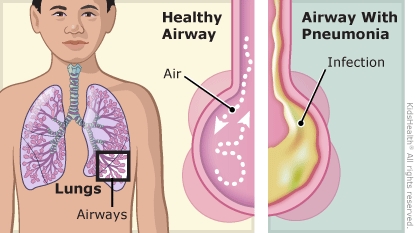Bacterial Pneumonia: How to Care for Your Child
Pneumonia is an infection in airways of the lungs. It is caused by different types of germs, such as bacteria or viruses. Your child's pneumonia was caused by bacteria. Most kids with bacterial pneumonia feel better a couple of days after starting on an antibiotic. Follow these instructions to care for your child.


-
Give your child the antibiotic as instructed by your health care provider.
-
If your child has a fever and your health care provider says it's OK, give one of the following exactly as instructed:
-
acetaminophen (such as Tylenol® or a store brand)
-
ibuprofen (such as Advil®, Motrin®, or a store brand)
-
Don't give your child aspirin because it's been linked to a rare but serious illness called Reye syndrome.
-
To soothe your child's cough:
-
Run a cool-mist humidifier, especially when your child is sleeping. Clean after each use.
-
If your child is older than 12 months, it's OK to give 1–2 teaspoons of honey at night. If your child is under 12 months old, do not give honey.
-
If your child is over 6 years old and is not at risk for choking, it's OK to give a cough drop or hard candy.
-
Don't give any cough or cold medicines if your child is under 6 years old. They can cause serious side effects. If your child is older than 6 years, ask your health care provider before you give cough or cold medicines.
-
Let your child rest as much as needed.
-
Give your child plenty of liquids. If it is easier for your child, give small amounts of liquid using a spoon or medicine dropper.
-
Don't allow anyone to smoke around your child. It can make your child cough more and get more lung infections.
-
Be sure your child has had all recommended vaccines. Some can help prevent certain kinds of pneumonia.

Your child:
-
has trouble taking the antibiotic
-
is not eating or drinking
-
has a new or higher fever
-
is not getting better after 2 days on the antibiotic
-
seems to be getting worse
-
has a cough that continues for more than a few weeks
-
has any of these signs of dehydration:
-
a dry or sticky mouth
-
peeing less
-
no tears when crying

Your child:
Call 911 if your child is struggling to breathe or turns blue.

How is bacterial pneumonia diagnosed? To diagnose bacterial pneumonia, health care providers look at a child's age and symptoms such as fever, chest pain, and wheezing. Sometimes they do a chest X-ray.
What happens in bacterial pneumonia? If bacteria get into the lungs, the airways swell and get irritated. They also fill with white blood cells (germ-fighting cells) and mucus. This blocks the airways and leads to coughing and sometimes breathing problems.
How does pneumonia spread? People can get the germs that cause pneumonia by:
-
breathing in the germ after someone with pneumonia coughs or sneezes
-
touching the germ (for example, on a dirty tissue), then touching their mouth, nose, or eyes
-
sharing something (like utensils or a glass) with someone who has pneumonia
To help prevent the spread of germs:
-
Teach kids to cough or sneeze into a tissue or into their elbow or upper arm (not their hands).
-
All family members should wash their hands well and often using soap and water. They should scrub for at least 20 seconds, rinse, and dry thoroughly. This is especially important after coughing or sneezing and before eating or preparing food. If soap and water are not available, use a hand sanitizer with at least 60% alcohol.